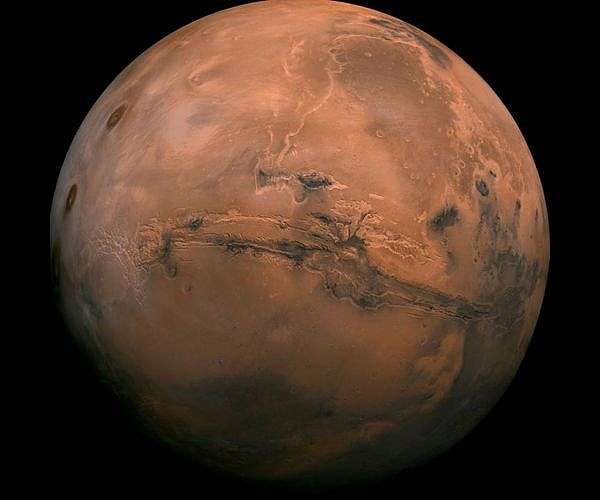Have we been wrong about why Mars is red
by Erica Marchand
Paris, France (SPX) Feb 26, 2025
New research combining spacecraft data from the European Space Agency (ESA) and NASA with advanced laboratory experiments suggests that Mars developed its distinctive red hue much earlier in its history than previously assumed. Scientists found that the planet’s iron-rich dust likely rusted during a time when liquid water was more abundant on the surface.
Mars has long been recognized by its striking red appearance, attributed to iron oxide-rust-present in its dust. This rusting process was thought to have occurred through chemical reactions between iron in the planet’s rocks and either limited surface water or atmospheric oxygen. Over billions of years, wind erosion broke down these rusted materials, spreading the fine iron oxide dust across the planet.
However, iron oxides exist in various forms, and the specific composition of Mars’s rust has been the subject of scientific debate. Understanding the formation of these iron oxides provides insights into the planet’s environmental conditions, including its potential for past habitability.
Previous spacecraft observations failed to detect water within the iron oxides, leading researchers to conclude that hematite, a type of iron oxide that forms under dry conditions, was responsible for the planet’s red coloration. This supported the idea that Mars’s oxidation happened gradually over billions of years, long after its wet period had ended.
But new research utilizing a combination of orbital and laboratory data challenges this assumption. The latest findings reveal that Mars’s dust composition more closely resembles ferrihydrite, an iron oxide that contains water and forms rapidly in the presence of cool liquid water. The presence of ferrihydrite indicates that Mars’s rusting process began much earlier, when water still covered parts of the surface.
“We were trying to create a replica martian dust in the laboratory using different types of iron oxide. We found that ferrihydrite mixed with basalt, a volcanic rock, best fits the minerals seen by spacecraft at Mars,” said lead author Adomas Valantinas, a postdoctoral researcher at Brown University in the United States. Valantinas initiated this research at the University of Bern in Switzerland, analyzing ESA’s Trace Gas Orbiter (TGO) data.
“Mars is still the Red Planet. It’s just that our understanding of why Mars is red has been transformed. The major implication is that because ferrihydrite could only have formed when water was still present on the surface, Mars rusted earlier than we previously thought. Moreover, the ferrihydrite remains stable under present-day conditions on Mars.”
While previous studies suggested ferrihydrite might be present in Martian dust, Valantinas and his team have now provided the most comprehensive evidence by integrating space mission data with advanced lab-based techniques.
To replicate Martian dust, the researchers used a specialized grinding machine to produce dust particles as small as 1/100th the width of a human hair. They then analyzed these particles using the same spectral techniques employed by orbiting spacecraft to ensure accurate comparisons, confirming that ferrihydrite best matched the observed Martian dust.
“This study is the result of the complementary datasets from the fleet of international missions exploring Mars from orbit and at ground level,” said Colin Wilson, ESA’s project scientist for Mars Express and the TGO mission.
Analysis from Mars Express revealed that even the most dust-covered regions of the planet contain water-rich minerals. Meanwhile, the TGO’s unique orbit allowed it to observe the same region under varying lighting conditions, helping researchers distinguish between particle size and composition-critical factors for accurately recreating Martian dust in the lab.
Data from NASA’s Mars Reconnaissance Orbiter, along with ground-based measurements from NASA’s Curiosity, Pathfinder, and Opportunity rovers, further supported the presence of ferrihydrite in the planet’s dust.
“We eagerly await the results from upcoming missions like ESA’s Rosalind Franklin rover and the NASA-ESA Mars Sample Return, which will allow us to probe deeper into what makes Mars red,” added Wilson.
Some of the samples collected by NASA’s Perseverance rover, now awaiting return to Earth, include dust. Once these samples reach laboratories, scientists will be able to precisely measure the ferrihydrite content and further refine their understanding of Mars’s water history and its potential to have supported life.
Until then, the mystery of Mars’s red dust continues to captivate scientists and stargazers alike.
Research Report:Detection of ferrihydrite in Martian red dust records ancient cold and wet conditions on Mars
Related Links
Mars Express at ESA
Mars News and Information at MarsDaily.com
Lunar Dreams and more

